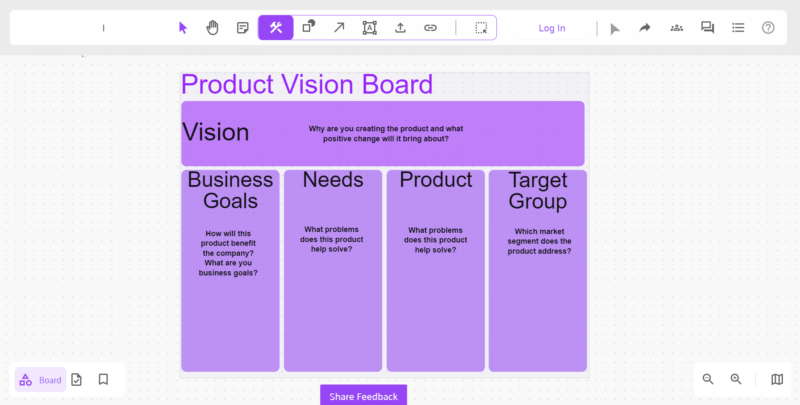Design thinking is a method that focuses on a solution-oriented approach to solving problems in your product or service. It’s very useful for solving complex problems that are not clearly defined. This method takes you through a series of stages that help you understand the users involved, identify issues from a user’s point of view, and brainstorm sessions using a hands-on approach. Read this article to learn about using Vision for Design Thinking.
Benefits of using vision boards for design thinking
The following are the benefits of using vision boards to help you stay on track with your business goals:
Helps you Focus
Making a vision board allows you to focus on what truly matters. Before creating your board, it’s essential to reflect on your goals and targets and list them down. You’ll remember your detailed game plan by making a vision board that reflects these goals through pictures, questions, phrases, and ideas.
Visual Manifestation
When you look at your vision board, envision yourself having achieved all of your listed goals and objectives. When you repeat this process enough times, the images get embedded in your subconscious mind.
Daily Reminders
When your goals become at the forefront of your mind, you are more likely to attain them. By looking at your vision board every day, you’re reminding yourself frequently.
Inspiration in difficult times
Your vision board will help you stay inspired through tough times. You can use your vision board to remind yourself of the reasons behind your efforts and what you stand to achieve by persevering.
To learn more about vision boards, check out our article on why they work and how to make one.
The five stages of design thinking
To understand how you can use Vision Boards for Design Thinking, let’s go through the five stages proposed by the Hasso-Plattner Institute of Design at Stanford.
- Empathize
- Define (the problem)
- Ideate
- Prototype
- Test
Let’s discuss each stage of the process in greater detail:
Empathize
The first step is gaining an empathic understanding of the problem at hand. Looking at a particular problem from an empathetic view allows you to set your assumptions aside and focus on gaining insights from users and their specific needs.
You may accomplish this by contacting specialists to learn more about the area of concern, watching, interacting, and empathizing with people to understand their experiences and motives. Immerse yourself in the design process and think from the users’ perspective to develop a better personal grasp of the issues involved.
The more information you gather in this stage, the better. It will allow you to develop the best possible understanding of the users, their needs, and the problems that underlie the development of your product.
Define
During the second stage, you gather the information from the previous step and analyze your observations to clearly define the main issues you and your team have identified.
The Define stage will assist your team in gathering new ideas for features, functionalities, and any other aspects that will allow them to solve problems.
Ideate
During the third stage, you can start generating ideas. After the first two stages, you now understand your users and their needs and define your product or service’s problems. With this information, you can start brainstorming with your team and identify new solutions to your problems. There are many ways of Ideation.
Prototype
After you’ve developed a detailed plan to fix your problems, you can now produce inexpensive, scaled-down versions of the product or its specific features. This is an iterative process that helps you figure out solutions to your problems.
Since this is an experimental stage, your goal should be to identify the best possible solutions to the limitations identified in the previous steps.
The solutions are built into prototypes, one by one. They are investigated and either approved, enhanced and re-examined based on user experiences or rejected. Throughout this process, the design team will have developed a deeper understanding of the product’s limits and current challenges. Giving them a clearer picture of how real users behave, think, and feel while engaging with the final product.
Test
Finally, once you’ve created a final prototype that addresses all of your key concerns. It’s now essential to rigorously test the entire product utilizing the solutions discovered during prototyping.
This is the fifth and final stage of the model. Nonetheless, it is an iterative process.
During this phase, changes and adjustments are made to rule out the best solutions and gain a thorough grasp of the product and its users.
Learn more: Why Vision Board Works and How to Make One?
How to incorporate vision boards with design thinking
An added advantage of incorporating vision boards with design thinking is that you can collaborate on a canvas virtually with your team. To learn more about making digital vision boards, check out our post on how to make a vision board online.
Here’s an example of a vision board created using our Online Whiteboard.

Most Recent Posts
Explore the latest innovation insights and trends with our recent blog posts.













